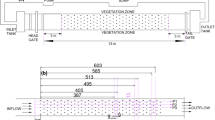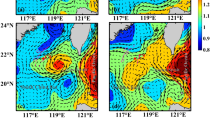Abstract
A newly developed tow-yo profiler (YODA Profiler) and a fully nonhydrostatic numerical model, SUNTANS, are used in this study to investigate river plume mixing in Otsuchi Bay, a ria estuary located in Iwate, Japan. Several field campaigns were conducted in the bay during early summer, late summer, and late winter. The YODA Profiler reveals fine features related to a shallow river plume that experiences rapid mixing events during the summer campaigns with a time scale of O(1) hour. These events coincide with strong baroclinic currents and large fluctuations in thermocline and pycnocline depths related to shoaling internal tides. The combined effects of wind stress and baroclinic flow appear to generate a strong shear near the surface layer and enhance mixing of the river plume, with typical eddy diffusivity values of O(10−4) m2 s−1. To investigate the physical mechanisms involved, numerical simulations are conducted with tidal and wind forcing. Analysis of tidal forcing mechanisms reveals that mixing near the river mouth (and upstream) is dominated by the barotropic tide, while turbulent mixing in the middle of the bay is significantly enhanced by the baroclinic internal tide. Wind forcing is also important for river plume dynamics; along-channel wind forcing mixes the river plume and transports it horizontally. Overall, this study suggests that all three forcing mechanisms (barotropic tide, baroclinic tide, and wind) are important for mixing processes of the river plume in Otsuchi Bay.















Similar content being viewed by others
References
Anbo A, Otobe H, Takagi M (2005) On the river water discharged into Otsuchi Bay. Report of International Coastal Marine Research Center, 30, p 4–8 (in Japanese)
Bourgault D, Morsilli M, Richards C, Neumeier U, Kelley DE (2014) Sediment resuspension and nepheloid layers induced by long internal solitary waves shoaling orthogonally on uniform slopes. Cont Shelf Res 72:21–33
Doubell MJ, Yamazaki H, Li H, Kokubu Y (2009) An advanced laser-based fluorescence microstructure profiler (TurboMAP-L) for measuring bio-physical coupling in aquatic systems. J Plankton Res 31:1441–1452
Foloni-Neto H, Lueck R, Mabuchi Y, Nakamura H, Arima M, Yamazaki H (2014) A new quasi-horizontal glider to measure biophysical microstructure. J Atmos Ocean Technol 31:2278–2293
Fringer OB, Gerritsen M, Street RL (2006) An unstructured-grid, finite-volume, nonhydrostatic, parallel coastal ocean simulator. Ocean Model 14:139–173
Fu LL, Holt B (1982) Seasat views oceans and sea ice with synthetic-aperture radar. NASA/JPL Publication 81–120, California Institute of Technology, Pasadena
Gille ST, Llewellyn Smith SG, Lee SM (2003) Measuring the sea breeze from QuikSCAT scatterometry. Geophys Res Lett 30(3):1114
Hasegawa D, Yamazaki H, Ishimaru T, Nagashima H, Koike Y (2008) Apparent phytoplankton bloom due to island mass effect. J Mar Syst 69(3):238–246
Kay DJ, Jay DA (2003) Interfacial mixing in a highly stratified estuary 1. Characteristics of mixing (1978–2012). J Geophys Res Oceans 108(3):3072
Kilcher LF, Nash JD (2010) Structure and dynamics of the Columbia River tidal plume front. J Geophys Res Oceans (1978–2012) 115(C5):C05S90
Kokubu Y, Yamazaki H, Nagai T, Gross ES (2013) Mixing observations at a constricted channel of a semi-closed estuary: Tokyo Bay. Cont Shelf Res 69:1–16
Kourafalou VH, Lee TN, Oey LY, Wang JD (1996) The fate of river discharge on the continental shelf: 2. Transport of coastal low-salinity waters under realistic wind and tidal forcing. J Geophys Res Oceans 101(C2):3435–3455
Ledwell JR, Montgomery ET, Polzin KL, St. Laurent LC, Schmitt RW, Toole JM (2000) Evidence for enhanced mixing over rough topography in the abyssal ocean. Nature 403:179–182
Leichter JJ, Wing SR, Miller SL, Denny MW (1996) Pulsed delivery of subthermocline water to Conch Reef (Florida Keys) by internal tidal bores. Limnol Oceanogr 41(7):1490–1501
Lien RC, Henyey F, Ma B, Yang YJ (2014) Large-amplitude internal solitary waves observed in the northern South China Sea: properties and energetics. J Phys Oceanogr 44(4):1095–1115
MacDonald DG, Geyer WR (2004) Turbulent energy production and entrainment at a highly stratified estuarine front. J Geophys Res Oceans 109:C05004
MacKinnon JA, Gregg MC (2003) Mixing on the late-summer New England shelf—solibores, shear, and stratification. J Phys Oceanogr 33(7):1476–1492
Masunaga E, Yamazaki H (2014) A new tow-yo instrument to observe high-resolution coastal phenomena. J Mar Syst 129:425–436
Mayer LM, Keil RG, Macko SA, Joye SB, Ruttenberg KC, Aller RC (1998) Importance of suspended particulates in riverine delivery of bioavailable nitrogen to coastal zones. Global Biogeochem Cycles 12(4):573–579
Möller OO Jr, Piola AR, Freitas AC, Campos EJD (2008) The effects of river discharge and seasonal winds on the shelf off southeastern South America. Cont Shelf Res 28(13):1607–1624
Moum JN, Smyth WD (2001) Upper ocean mixing processes. Encycl Ocean Sci 6:3093–3100
Moum JN, Farmer DM, Smyth WD, Armi L, Vagle S (2003) Structure and generation of turbulence at interfaces strained by internal solitary waves propagating shoreward over the continental shelf. J Phys Oceanogr 33:2093–2112
Nakatsuka T, Toda M, Kawamura K, Wakatsuchi M (2004) Dissolved and particulate organic carbon in the Sea of Okhotsk: transport from continental shelf to ocean interior. J Geophys Res Oceans 109:C09S14
Nash JD, Moum JN (2005) River plumes as a source of large-amplitude internal waves in the coastal ocean. Nature 437:400–403
Nash JD, Kilcher LF, Moum JN (2009) Structure and composition of a strongly stratified, tidally pulsed river plume. J Geophys Res Oceans 114:C00B12
Okazaki M (1990) Internal tidal waves and internal long period waves in the Sanriku coastal seas, eastern coast of northern Japan. La mer 28:5–29
Okazaki M (1994) The circulation of sea water and variation of the properties in some bays of Sanriku Coast, eastern coast of northern Japan. Bull Coast Oceanogr 32:15–28 (in Japanese)
Orton PM, McGillis WR, Zappa CJ (2010) Sea breeze forcing of estuary turbulence and air-water CO2 exchange. Geophys Res Lett 37(13):L13603
Osborn TR (1980) Estimates of the local rate of vertical diffusion from dissipation measurements. J Phys Oceanogr 10:83–89
Otobe H, Onishi H, Inada M, Michida Y, Terazaki M (2009) Estimation of water circulation in Otsuchi Bay, Japan inferred from ADCP observation. Coast Mar Sci 33(1):78–86
Pawlowicz R, Beardsley B, Lentz S (2002) Classical tidal harmonic analysis including error estimates in MATLAB using T_TIDE. Comput Geosci 28(8):929–937
Petruncio ET, Rosenfeld LK, Paduan JD (1998) Observations of the internal tide in Monterey Canyon. J Phys Oceanogr 28:1873–1903
Pineda J (1994) Internal tidal bores in the nearshore: warm-water fronts, seaward gravity currents and the onshore transport of neustonic larvae. J Mar Res 52(3):427–458
Richards C, Bourgault D, Galbraith PS, Hay A, Kelley DE (2013) Measurements of shoaling internal waves and turbulence in an estuary. J Geophys Res Oceans 118(1):273–286
Sharples J, Moore CM, Hickman AE, Holligan PM, Tweddle JF, Palmer MR, Simpson JH (2009) Internal tidal mixing as a control on continental margin ecosystems. Geophys Res Lett 36(23):L23603
Simpson JH (1997) Physical processes in the ROFI regime. J Mar Syst 12:3–15
Simpson JH, Williams E, Brasseur LH, Brubaker JM (2005) The impact of tidal straining on the cycle of turbulence in a partially stratified estuary. Cont Shelf Res 25(1):51–64
Van Gastel P, Ivey GN, Neuleners M, AntenucciJP Fringer OB (2009) Seasonal variability of nonlinear internal wave climatology on the Australian North West Shelf. Cont Shelf Res 29:1373–1383
Vlasenko V, Hutter K (2002) Numerical experiments on the breaking of solitary internal waves over a slope-shelf topography. J Phys Oceanogr 32:1779–1793
Walter RK, Woodson CB, Arthur RS, Fringer OB, Monismith SG (2012) Nearshore internal bores and turbulent mixing in southern Monterey Bay. J Geophys Res Oceans 117(C7):C07017
Wang Z, Goodman L (2009) Evolution of the spatial structure of a thin phytoplankton layer into a turbulent field. Mar Ecol Prog Ser 374:57–74
Yin K, Goldblatt RH, Harrison PJ, St. John MA, Clifford PJ, Beamish RJ (1997) Importance of wind and river discharge in influencing nutrient dynamics and phytoplankton production in summer in the central Strait of Georgia. Mar Ecol Progr Series 161:173–183
Acknowledgments
We thank the crew of the R/V Grand-maillet (the University of Tokyo), the fishing boat Senshu-maru (Shin-Otsuchi Fishery), and the fishing boat Daimutsu-maru (Shin-Otsuchi Fishery) for their time and help. The authors gratefully acknowledge Kiyoshi Tanaka, Hideki Fukuda, Yuichiro Nishibe, and Yuka Saito for coordinating our observation plans. We are indebted to the members of Laboratory of Ocean Ecosystem Dynamics (Tokyo University of Marine Science and Technology) for their assistance with the deployment of the instruments. This study was supported by funding from Tohoku Ecosystem-Associated Marine Sciences (TEAMS), a research program launched by the Ministry of Education, Culture, Sports, Science and Technology (MEXT).
Author information
Authors and Affiliations
Corresponding author
Rights and permissions
About this article
Cite this article
Masunaga, E., Fringer, O.B. & Yamazaki, H. An observational and numerical study of river plume dynamics in Otsuchi Bay, Japan. J Oceanogr 72, 3–21 (2016). https://doi.org/10.1007/s10872-015-0324-2
Received:
Revised:
Accepted:
Published:
Issue Date:
DOI: https://doi.org/10.1007/s10872-015-0324-2




